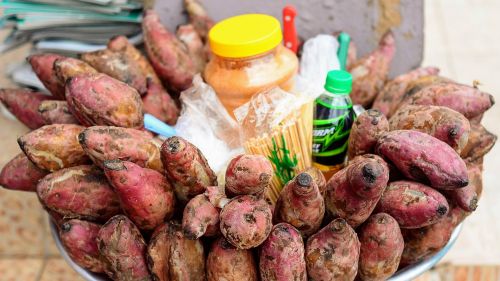Using Cutting-Edge Science to Protect African Farmers' Potato Crops, Incomes, and Food Security

Guest authors Chris Kennedy and Bob Easter examine how a collaborative effort to bring a disease-resistant potato variety to market in Africa can promote global food security.
Many African smallholder farmers face each growing season with a sense of hope and apprehension.
If their crops are abundant then their families are well fed and they can sell their surplus to buy other things their family needs—like clothes, school fees, or medicine.
Yet if their crops fail, they are among the most vulnerable people in the world. There are generally no safety nets, no government price supports or loans to support them—and no ready supply of food to feed their families.
An infestation of locusts—or a plant pathogen like a bacteria, a virus or a water mold—can wipe out their crop and make their lives precarious, affecting their nutrition, their health, and their economic future.
Less than a century ago, many farmers in the United States (including some of Bob’s ancestors) faced the same difficulties nearly every growing season, with consequences just as stark.
While things are still challenging for American farmers, they have a lot more options to protect their crops and their families. Research conducted in the public and private sectors has developed new technology, methods, and germplasm (seeds), that have made the US one of the most advanced agricultural producers in the world.
However, for African farmers with poor infrastructure and scarce agricultural inputs like fertilizer and irrigation, their solutions have to be simpler and inexpensive.
Solutions Start with Good Seed
It has to start with good seed.
Their seed has to have the genetic traits to not only produce more grain or fruit or tubers, but it also has to have the traits that make the plant resistant to the crops’ natural enemies and climate threats.
For potatoes, for the past 170 years the most challenging foe has been the plant disease “potato late blight” caused by a water mold called Phytophthora infestans. During the Great Hunger (or Gorta Mór in the Irish language) late blight destroyed the Irish potato crop for five straight years from 1845 to 1850.
This caused tremendous human suffering, triggered the deaths of at least 1 million Irish from starvation and disease, and compelled over a million others to board ships and leave their homes forever, many settling here in the United States (including some of Chris’ ancestors).
Late blight has been incredibly resilient, and to this day still can destroy 70 percent or more of African potato crops. Farmers in wealthier nations spray fungicide weekly to protect their potatoes, but these treatments may be unavailable or unaffordable in developing countries.
African potato production has doubled in the past 25 years, mostly in East Africa. It’s an attractive crop because potato plants produce more nutritious food more quickly, on less land, and in harsher climates than any other major crop.
In Kenya and Uganda, over 1 million smallholder farmers depend upon potatoes for their sustenance and incomes, but late blight now costs farmers in East Africa and throughout the developing world $10 billion each year, threatening their families’ income, nutrition, and health.
Potato growers abandoned a 40-year effort to use conventional breeding to develop new potato varieties resistant to late blight. The pathogen has evolved so quickly that it always overcomes new resistant varieties. Late blight is also becoming resistant to fungicides, and farmers everywhere are looking for a durable solution.
Now There is Hope for a Solution to Late Blight
Now there is hope that we finally have an answer to the scourge of late blight. The International Potato Center has developed, in partnership with USAID, a cisgenic modification of local African potato varieties to add three genes from wild potato relatives which are resistant to late blight, and are passed on to subsequent growing seasons of potatoes (through their tubers which serve as “seeds” for the next planting season).
With additional support from the Evanston, Illinois-based 2Blades Foundation, this new disease-resistant potato has been tested in Ugandan fields for the past five years and “consistently displayed complete resistance, not needing a single drop of chemical fungicide.” The new variety tripled yields, potentially increasing farmers’ incomes by up to 40 percent.
Farmers are eager to try the new potato variety, which will require less land, water, and chemicals.
The current goal is to bring this disease-resistant potato variety to market, gathering data from field trials and preparing the potatoes for bulking and distribution.
This collaborative effort—between scientists, the US government, and a Chicago-area research organization—is an example of a very promising pathway to promote global food security.
Working with our best scientists, farmers, and policymakers we now have the tools we need to increase production of enough safe and nutritious food to help support the world’s most vulnerable smallholders, and to feed the 2 billion additional people who will live on the earth by 2050.
It’s a vision worth pursuing because the challenges are so formidable, and the solutions are very much within our reach.